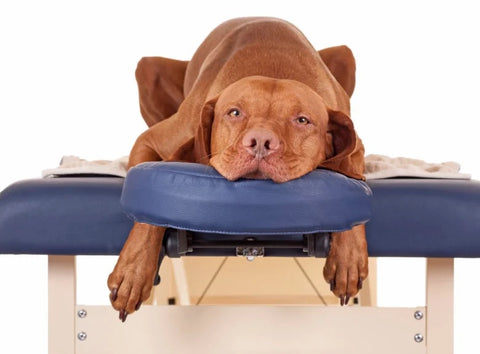
Welcome to a fascinating journey into the world of canine health and wellness! As pet owners, we are constantly seeking ways to enhance the lives of our furry companions. But have you ever wondered about the hidden secrets that lie within your dog's body? Unlocking the secrets of understanding the pressure points in dogs can lead to optimal health and wellness for your beloved four-legged friend.
From ancient Chinese medicine to modern-day techniques, this article will delve into the intricate network of pressure points that can be manipulated to alleviate pain, reduce stress, and promote overall well-being in dogs.
Whether you are a seasoned pet owner or a newcomer to the world of dog care, join us as we explore the fascinating world of pressure points in dogs and discover how you can unlock their potential for a happier and healthier canine companion.
The benefits of understanding pressure points for dog owners
Understanding the pressure points in dogs can provide numerous benefits for dog owners. By familiarising yourself with these specific points, you can effectively address various health issues, improve your dog's overall well-being, and deepen the bond you share with your furry friend.
First and foremost, understanding pressure points allows you to alleviate pain in your dog. Just like humans, dogs can experience discomfort and soreness in different areas of their bodies. By applying targeted pressure to specific points, you can provide natural pain relief and improve their quality of life.
Furthermore, pressure points can be used to reduce stress and anxiety in dogs. Many dogs experience fear and anxiety in certain situations, such as during thunderstorms or when visiting the veterinarian. By utilising pressure points, you can help your dog relax, ease their anxiety, and create a sense of calm in stressful situations.
Lastly, understanding pressure points in dogs can promote overall wellness. By stimulating specific points, you can boost your dog's immune system, improve circulation, and enhance their overall vitality. This can result in a healthier, happier, and more vibrant four-legged companion.
Common pressure points in dogs and their functions
Dogs have numerous pressure points throughout their bodies, each serving a specific function and offering unique benefits. Here are some commonly targeted pressure points in dogs:
1. The Bai Hui Point: Located at the top of the head, this point is often referred to as the "crown chakra" in traditional Chinese medicine. Stimulating this point can help relieve pain, promote mental clarity, and improve overall well-being.
2. The Shen Men Point: Found on the inner flap of the ear, this point is often referred to as the "gate to heaven." Applying gentle pressure to this point can help reduce anxiety, calm the mind, and promote relaxation.
3. The Hoku Point: Situated between the thumb and index finger on the inside of the front leg, this point is commonly used for pain relief. Stimulating the Hoku point can help alleviate discomfort in various areas of the body, including the head, neck, and shoulders.
4. The Yin Tang Point: Located between the eyes, this point is often referred to as the "third eye" in traditional Chinese medicine. Applying gentle pressure to this point can help relieve headaches, reduce stress, and promote a sense of balance.
By understanding the functions of these common pressure points in dogs, you can effectively target specific areas of concern and provide relief in a natural and holistic manner.
Techniques for applying pressure to specific points
When it comes to applying pressure to specific points in dogs, there are various techniques you can utilise. Here are some commonly used methods:
1. Finger pressure: Using your fingers, apply gentle pressure to the desired point. Start with light pressure and gradually increase as your dog becomes more comfortable. It's important to be mindful of your dog's response and adjust the pressure accordingly.
2. Massage: Incorporating massage techniques can be beneficial when applying pressure to specific points. Use circular motions or gentle strokes to stimulate the desired area. This can help relax your dog's muscles, improve circulation, and enhance the effectiveness of pressure point therapy.
Remember, each dog is unique, and what works for one may not work for another. It's important to observe your dog's response and adjust your technique accordingly. Always approach pressure point therapy with patience, care, and respect for your dog's comfort levels.
Using pressure points for relaxation and stress relief in dogs
One of the most significant benefits of understanding pressure points in dogs is their ability to promote relaxation and relieve stress. Just like humans, dogs can experience anxiety and tension in various situations. By utilizing pressure points, you can effectively help your dog relax and create a sense of calm.
The Shen Men point, located on the inner flap of the ear, is particularly effective for stress relief. Gently massaging or applying pressure to this point can help reduce anxiety, calm the mind, and promote a state of relaxation. This can be especially useful during thunderstorms, fireworks, or other stressful events that may trigger fear in your dog.
Another pressure point to consider is the Bai Hui point, located at the top of the head. Stimulating this point can promote mental clarity and relaxation, making it an ideal choice for dogs who are easily overwhelmed or anxious.
When applying pressure to these points, it's essential to create a calm and quiet environment. Find a comfortable space where your dog feels safe and secure, and take your time to establish a gentle and soothing touch. By incorporating pressure point therapy into your dog's routine, you can help them manage stress more effectively and create a peaceful environment for both of you.
Pressure points for pain management and injury prevention
Understanding pressure points in dogs can be particularly beneficial when it comes to managing pain and preventing injuries. Dogs, just like humans, can experience discomfort and soreness in various areas of their bodies. By targeting specific pressure points, you can provide natural pain relief and promote overall well-being.
The Hoku point, located between the thumb and index finger on the inside of the front leg, is commonly used for pain management. Applying pressure to this point can help alleviate discomfort in areas such as the head, neck, and shoulders. This can be particularly useful for dogs with arthritis, muscle soreness, or joint pain.
Additionally, the Yin Tang point, located between the eyes, can help relieve headaches, reduce stress, and promote a sense of balance. This point is often used in combination with other pressure points to address pain and discomfort in various areas of the body.
When applying pressure to these points for pain management, it's crucial to start with gentle pressure and gradually increase if your dog responds positively. Always be attentive to your dog's comfort levels and adjust your technique accordingly. If you have any concerns about your dog's health or are unsure about applying pressure to specific points, consult with a veterinarian or a qualified professional in canine pressure point therapy.
Pressure points for boosting the immune system and overall wellness
In addition to pain management and stress relief, understanding pressure points in dogs can also contribute to boosting the immune system and promoting overall wellness. By stimulating specific points, you can enhance your dog's vitality, improve circulation, and support their overall health.
The Bai Hui point, located at the top of the head, is known for its ability to promote mental clarity and overall well-being. By stimulating this point, you can help your dog feel more balanced, focused, and energized.
Another point to consider is the Shen Men point, located on the inner flap of the ear. Stimulating this point can help boost the immune system and improve overall vitality. This can be particularly beneficial during times when your dog may be more susceptible to illness or when they need an extra boost of energy.
By incorporating pressure point therapy into your dog's routine, you can help support their immune system, improve their overall wellness, and contribute to their overall longevity. However, it's important to remember that pressure point therapy should not replace regular veterinary care. Always consult with a veterinarian or a qualified professional before implementing any new therapies or techniques.
Incorporating pressure point therapy into your dog's daily routine
Now that you have a better understanding of pressure points in dogs and their benefits, you may be wondering how to incorporate this therapy into your dog's daily routine. Here are some tips to help you get started:
1. Start slowly: Introduce pressure point therapy gradually, allowing your dog to become familiar and comfortable with the process. Begin with short sessions and gradually increase the duration as your dog becomes more accustomed to the technique.
2. Create a calm environment: Find a quiet space where you and your dog can relax without distractions. Turn off any loud noises or music, and ensure the environment is comfortable and soothing for both of you.
3. Observe your dog's response: Pay attention to your dog's reactions and body language during the pressure point therapy. If your dog seems uncomfortable or shows signs of distress, adjust your technique or consult with a professional for guidance.
4. Be consistent: Incorporate pressure point therapy into your dog's routine on a regular basis. Consistency is key to achieving optimal results. Consider setting aside a specific time each day for these sessions.
5. Combine with other wellness practices: Pressure point therapy can be even more effective when combined with other wellness practices, such as regular exercise, a balanced diet, and mental stimulation. By taking a holistic approach to your dog's health and well-being, you can maximise the benefits of pressure point therapy.
Remember, every dog is unique, and what works for one may not work for another. It's important to be patient, observant, and responsive to your dog's individual needs and preferences. If you have any concerns or questions, consult with a veterinarian or a qualified professional who specialises in pressure point therapy for dogs.
Precautions and considerations when applying pressure to dogs
While pressure point therapy can be a beneficial practice for dogs, it's important to take certain precautions and considerations when applying pressure to your furry friend. Here are some guidelines to keep in mind:
1. Consult with a professional: If you are new to pressure point therapy or have any concerns about your dog's health, it's always a good idea to consult with a veterinarian or a qualified professional who specialises in canine pressure point therapy. They can provide guidance, ensure you are using the correct techniques, and address any specific concerns related to your dog's well-being.
2. Start with gentle pressure: When applying pressure to specific points, always start with gentle pressure and observe your dog's response. Gradually increase the pressure if your dog is comfortable and responsive. It's important to be mindful of your dog's comfort levels and adjust your technique accordingly.
3. Avoid sensitive areas: Be cautious when applying pressure to sensitive areas, such as the abdomen, groin, or areas with existing injuries or wounds. These areas may require special attention or should be avoided altogether. Always prioritise your dog's safety and well-being.
4. Monitor for signs of discomfort: Pay close attention to your dog's body language and signs of discomfort during pressure point therapy. If your dog shows signs of distress or discomfort, such as pulling away, whimpering, or showing signs of aggression, stop the session immediately and reassess your technique.
5. Personalise the therapy: Every dog is unique, and what works for one may not work for another. It's important to personalise the therapy to suit your dog's individual needs and preferences. Observe your dog's response, adjust your technique accordingly, and be open to exploring different approaches.
By taking these precautions and considerations into account, you can ensure that pressure point therapy is a safe and beneficial practice for your dog.
The power of pressure points for optimal health and wellness in dogs
Understanding the pressure points in dogs can unlock a world of possibilities for optimal health and wellness. From pain management to stress relief, pressure point therapy offers a natural and holistic approach to improving your dog's overall well-being. By familiarising yourself with common pressure points, learning proper techniques, and incorporating pressure point therapy into your dog's daily routine, you can provide them with the benefits of this ancient practice.
However, it's crucial to remember that pressure point therapy should not replace regular veterinary care. If you have any concerns about your dog's health or are unsure about applying pressure to specific points, consult with a veterinarian or a qualified professional who specialises in canine pressure point therapy.
As pet owners, we have the privilege and responsibility to enhance the lives of our furry companions. By unlocking the secrets of pressure points in dogs, we can create a happier, healthier, and more balanced life for our beloved four-legged friends. So, embark on this fascinating journey into the world of canine health and wellness, and discover the hidden potential within your dog's body.
©deliveryhound.com.au 2023






